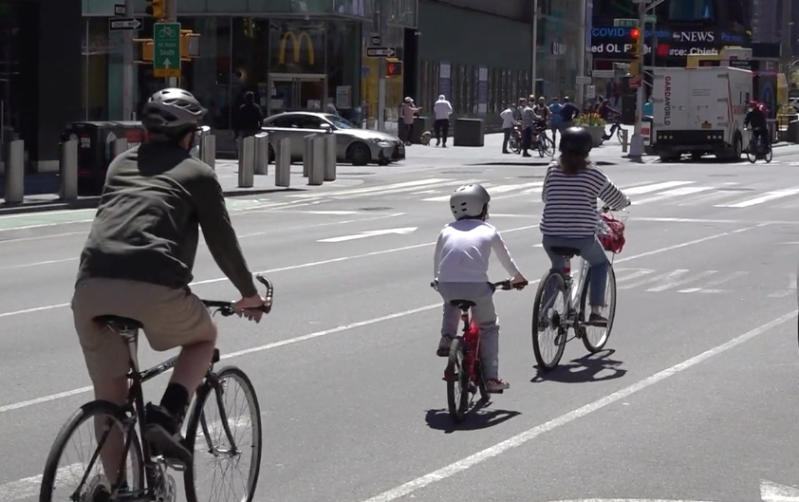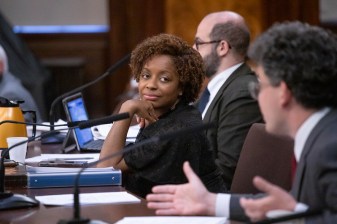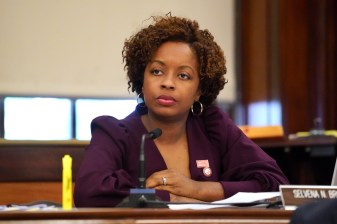Pols Want Every Kid in NYC to Learn How to Ride a Bike

Learning to ride a bike in New York should be like riding a bike!
Every student in the five boroughs should be able to learn how to safely ride a bike in the city, alongside long division, reading and science as part of their education, according to Council members Erik Bottcher (D-Chelsea), Rita Joseph (D-Flatbush) and Selvena Brooks-Powers (D-Southeast Queens), who introduced a resolution on Thursday calling on the Department of Education to teach bicycle safety in all public schools.
“Providing instruction in bicycle and traffic safety in schools, starting at an early age and continuing to reinforce such instruction throughout students’ years in school would be an effective measure to both promote cycling and prevent bicycle accidents and other safety incidents,” the resolution read.
Currently, schools across the state are required by law to teach students about traffic safety, which includes bicycling, according to a 2014 law. But the law doesn’t specify the length or scale of such a program, and, as such, is frequently ignored. Just six schools citywide per semester offer classes, according to Bottcher, reaching no more than a few thousand students out of the more than 1 million public school kids.
The Council members demand that the city do better to follow the law.
“Right now there is a kernel of a bike education program that shows a lot of promise. But it is a very small number of schools citywide. We want to see that program enlarged significantly,” said Bottcher.
? Did you know that New York State Education Law requires all school districts in the State to provide students with instruction in bicycle safety?
It's true: New York City schools should be providing bicycle safety instruction to all students. Unfortunately, few schools are. pic.twitter.com/eNSNUpIUKc
— Erik Bottcher (@ebottcher) April 28, 2022
Bottcher blames the Department of Education for not prioritizing its responsibility under the law. There are also logistical challenges such as managing and moving a fleet of bikes to schools all over the city, and ensuring a safe place for kids to practice.
“But these are not insurmountable challenges,” Bottcher said. “We need to try harder and do more.” (The Department of Education declined to comment for this story.)
The current program, run in partnership with the DOE, Department of Transportation, and Bike New York, starts with a Bicycle Safety Assembly, which includes a short film, and a Bike Jeopardy game. It focuses on basic instruction, like the do’s and don’ts of cycling, basic handling skills, how to stop and start, how to look over your shoulder without losing balance or a straight track, and being cognizant of drivers, especially the ones who illegally fling open their doors into the bike lane, according to Bottcher.
Bike New York staff train DOE educators to teach the kids — some of whom have never ridden a bike, and by the end of the classes are flying on two wheels. But the heart of the program, according to one instructor from Bike New York, is instilling in kids a love for biking and the freedom that it provides them.
“It’s normalizing cycling and making it a mainstream thing. It gets kids excited,” said Rich Conroy, director of education at Bike New York.
Advocates hailed the program, but said education alone can’t make the city’s perilous streets safer for kids, and that education and encouragement must come in conjunction with improving bike infrastructure and creating safe routes for students to get to and from school.
“Giving our students the skills they need to bike safely on our streets is a great way to encourage more kids to bike,” said Families for Safe Streets member Julie Huntington. “This announcement must come with an investment in building protected bike lanes and safe routes to school to keep our new riders safe.”
.@TransAlt is proud to support @ebottcher’s resolution to bring #bikeNYC education to every school in NYC, as mandated by NY State Law pic.twitter.com/auyRtTHzpI
— Juan Restrepo ? (@juaninQNS) April 28, 2022
And of course, the need for bike safety is only more paramount thanks to drivers, whose recklessness behind the wheel last year contributed to one of the deadliest years for traffic violence last year, and 64 fatalities in just the first few months of 2022, according to DOT.
“At the end of the day, the onus is on drivers. Drivers are in the vehicle that weighs thousands of pounds, traveling at high rates of speed. Drivers have a responsibility to be aware of bikers and aware of the fact that if they hit someone with their car, it’s very likely they could take their life,” said Bottcher.
But drivers, more than cyclists, are the ones who need a lesson in road safety, pols and advocates say. But little exists. Currently, New York State has notoriously lenient rules for getting a driver’s license, consisting of just four steps:
- Take an easy written test to get a learner’s permit.
- Drive for 50 hours (15 after sunset) with any adult who has a driver’s license. The adult need not have any specialized training (and there is no real verification process to confirm that the newbie driver has indeed practiced for 50 hours).
- Take the five-hour course (which, as of last year, could for the first time be taken online).
- Pass the road test.
But two progressive state pols want to change that by requiring learning drivers to practice with a professional driving instructor before getting behind the wheel on their own.
Senate bill 8667, introduced by Andrew Gounardes (D-Bay Ridge) and in the Assembly by Bobby Carroll (D-Park Slope), would, for the first time require drivers to complete six hours of practice “under the supervision of a driving school instructor” before they could take the road test and receive their license.
“For some drivers, the first time they take the wheel [as a licensed driver] they are in sole control of their car,” said Gounardes, adding that the currently lax rules contribute to road violence, citing a 2017 study that revealed that the biggest predictor of crashes was a lack of experience as a driver; the more time behind the wheel, the less likely a crash.
But that bill has not yet made it out of committee.


